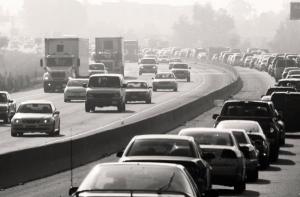
The daily commute may be taking more of a toll than people realize. A study by USC researchers and the California Air Resources Board found that up to half of Los Angeles residents’ total exposure to harmful air pollutants occurs while people are traveling in their vehicles.
Although the average Los Angeles driver spends about six percent (1.5 hours) of his or her day on the road, that period of time accounts for 33 to 45 percent of total exposure to diesel and ultrafine particles (UFP), according to the study published last year in the journal Atmospheric Environment. On freeways, diesel-fueled trucks are the source of the highest concentrations of harmful pollutants.
“If you have otherwise healthy habits and don’t smoke, driving to work is probably the most unhealthy part of your day,†said Scott Fruin, assistant professor of environmental health at the Keck School of Medicine. “Urban dwellers with long commutes are probably getting most of their UFP exposure while driving.â€
High air exchange rates that occur when a vehicle is moving make roadways a major source of exposure. Ultrafine particles are of particular concern because, unlike larger particles, they can penetrate cell walls and disperse throughout the body, Fruin said. Particulate matter has been linked to cardiovascular disease, but the ultrafine fraction on roadways appears to be more toxic than larger sizes.
Researchers measured exposure by outfitting an electric vehicle with nine, fast-response air pollution instruments. A video recorded surrounding traffic and driving conditions on freeways and arterial roads throughout the Los Angeles region. Measurements were collected during a three-month period from February to April 2003, and four typical days were selected for a second-by-second video and statistical analysis.
Results showed that the two main sources of pollution were diesel-fueled trucks on freeways and hard accelerations on surface streets. Surprisingly, overall congestion was only a factor on arterial roads and, even then, the highest concentrations of pollutants occurred only when vehicles were accelerating from a stop, Fruin said.
“This study was the first to look at the effect of driving and traffic conditions at this level of detail and to demonstrate the specific factors leading to the highest pollutant exposures for drivers,†Fruin said. “The extent that a specific type of vehicle—diesel trucks—dominated the highest concentration conditions on freeways was unexpected.â€
Driving with the windows closed and recirculating air settings can modestly reduce the particle pollution exposures but does not reduce most gaseous pollutants. Driving at speeds lower than 20 miles per hour can also reduce exposure, but none of these measures is as effective as simply cutting back on driving time, he said.
“Shortening your commute and spending less time in the car will significantly reduce your total body burden of harmful pollutants,†Fruin said.
Off-road transportation such as taking the train will have a significant impact. Biking or walking are alternatives that also provide valuable health benefits from exercise, he said.
This report underscores why as we move forward we must understand the impact that each of the promising innovations for cleaner automobiles will have for society. The Hydrogen Education Foundation is working toward that goal by educating people about the benefits of hydrogen vehicles in conjunction with our new H2 and You program. It’s important to note that some hydrogen applications virtually eliminate harmful carbon emissions, often emitting only water. As a result, the adoption of hydrogen cars will help to reduce greenhouse gases, the main cause of ultrafine particles (UFP), and thereby improve air quality.
A recent report from two of the leading fuel cell manufacturing companies, Ballard Power Systems and Plug Power, confirms this. The report is readily available at Plug Power’s website at http://www.plugpower.com/news/documents/GHG%20FINAL.pdf.
Additionally, as this report shows, one of the largest contributors of pollution are diesel-fueled trucks. Currently, several companies produce hydrogen-injection systems for diesel, gas, and natural gas engines: http://www.hydrogencarsnow.com/blog2/index.php/hydrogen-production/hydrogen-diesel-injection-developed-by-alternative-energy-corporation/ . This device can be added to any currently diesel engine system and will greatly reduce emissions and improve overall fuel efficiency and is available for purchase worldwide.
To learn more about the benefits of hydrogen, please visit http://www.h2andyou.org. In addition, the Hydrogen Expo and Conference, March 30 – April 3, is taking place in Sacramento, CA. If you live near or if you’re traveling to Sacramento, we invite you to join us and experience how hydrogen can have a positive impact on our lives. For more information about the Expo, please visit hydrogenconference.org.